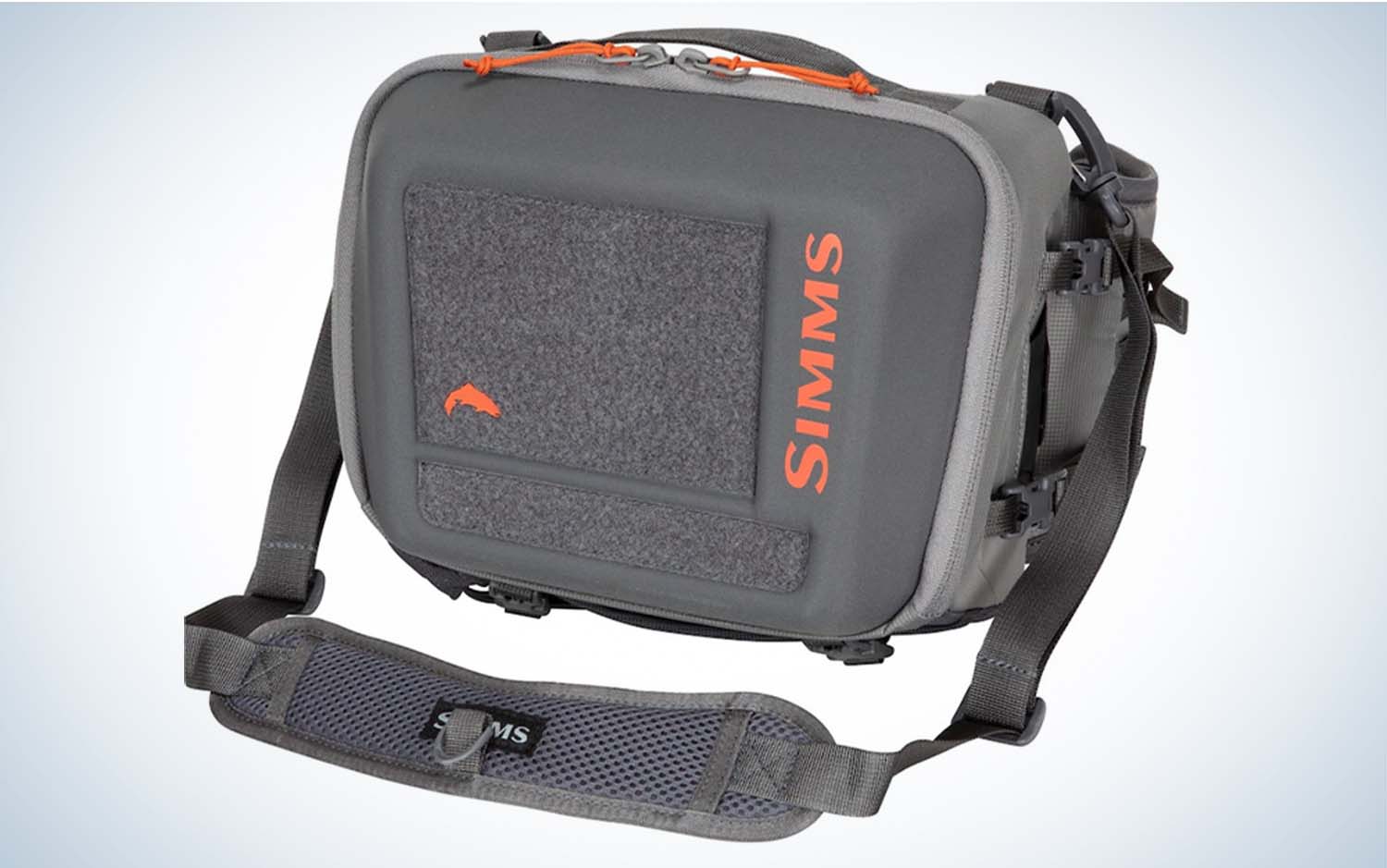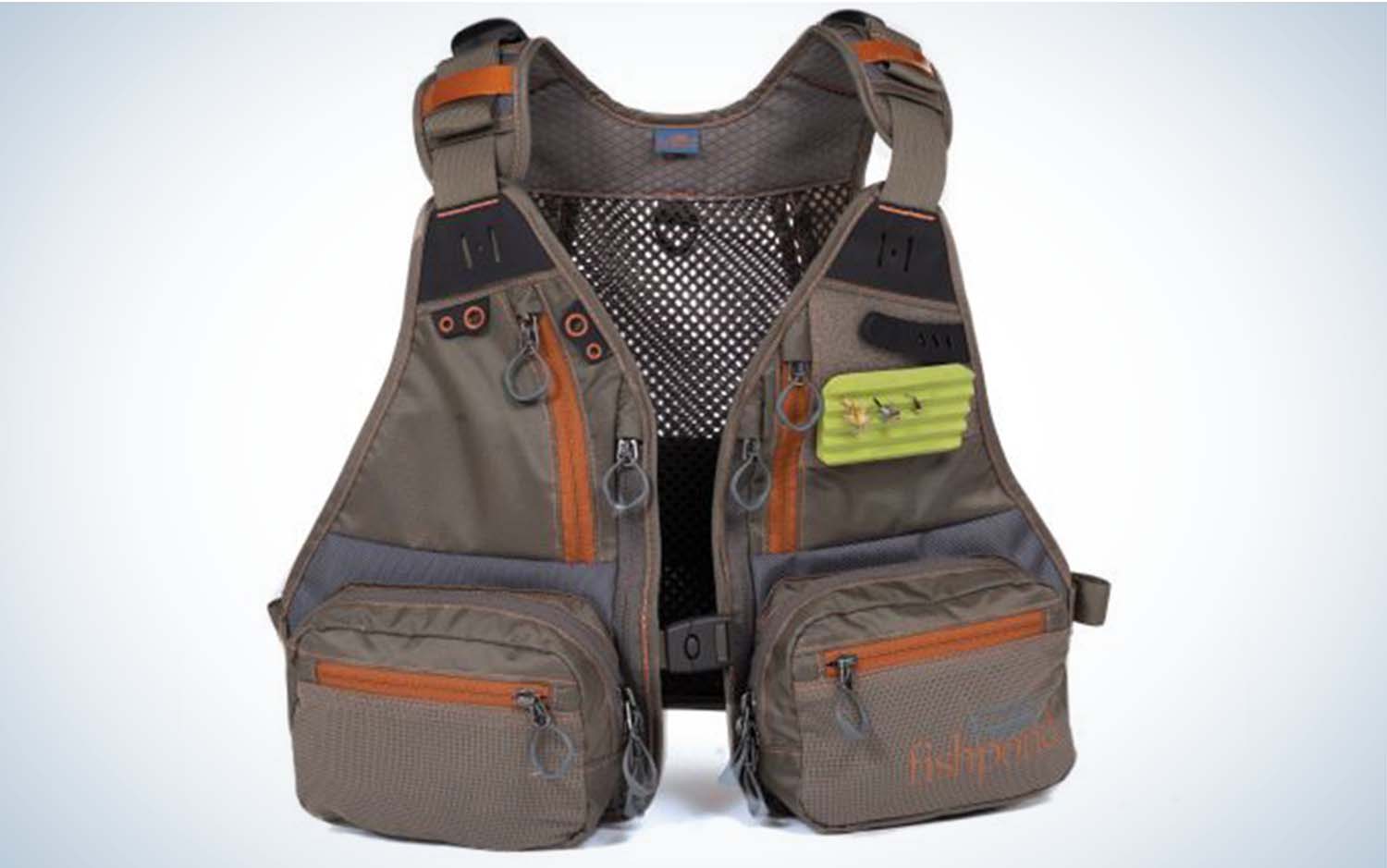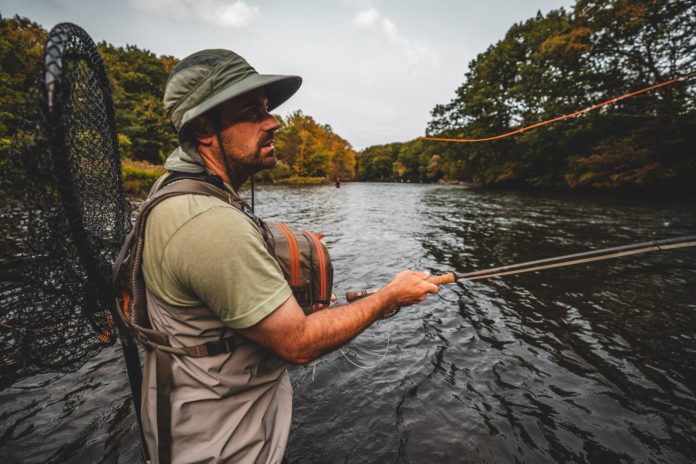Fly anglers need more than a rod, reel, and pocket full of flies for a day on the water. But you also don’t want a big tackle box when you’re wading. The solution is to find the best fly fishing vest, sling pack, or hip pack to carry your fly fishing gear.
During my first 30 years of fly angling, I used a vest for just about every type of fishing. In the last decade or so, that’s changed. I still use a vest for trout and bass fishing, but have branched out into sling packs and hip packs for some other types of angling. My fishing closet is getting full, yes, but the testing and investment I’ve made in all three have been well worth it. They all have their best uses.
Below, I’ve reviewed some of my favorite vests, sling packs, and hip packs from recent years.
Key Features
- Cinder color
- Weight: 1 pound, 9 ounces
- Made of Cordura nylon
- 24 pockets
- 2 built-in retractors
Why It Made the Cut
The G3 Guide has everything you want in a fly fishing vest, and it will last a lifetime.
Pros
- Ample storage with 24 total pockets
- Well-organized design means everything is easy to reach
Cons
- It could be too much storage for some—the temptation is to fill all of the pockets even if you don’t need to
- Velcro on inner pockets can wear out over time
Product Description
Simms has long been at the forefront of fishing vest designs, and the G3 Guide is the best they’ve ever made. It’s so good and well made that you can pass it down to your children someday. It’s comfortable—with mesh on the shoulders and a padded collar—and durable and water-resistant.
The two big vertical pockets on the chest exterior allow for more storage without getting in the way of your casting stroke. There’s ample room in the back pockets for rain gear. And there are lots of nice little touches to go along with the essentials, like the two built-in retractors (one for your nippers and one for your forceps, if you like) and a Velcro band on the chest that can hold your rod in place as you change your fly.

Key Features
- Tan color
- 65% polyester, 35% cotton
- Nine pockets
- Fleece fly keeper
Why It Made the Cut
If you’re a new angler, the Redding Clark Fork Vest is a great place to start. It has plenty of storage, and it’ll get you on the water without stretching your budget.
Pros
- Cost
- Mesh makes it lightweight
Cons
- Velcro on pockets can get weathered quickly
- Lack of storage and a retractor
Product Description
The Clark Fork is an excellent vest for someone who is brand new to fly fishing. The 11 pockets (nine of which are on the outside) will most likely provide enough space for the novice’s gear. The mesh on the exterior keeps the vest lightweight and cool on hot days, and the pocket on the back is big enough for a rain jacket.
Durability is a bit of an issue: the Velcro on the pockets won’t last too long. And some might want more pockets for storage, as well as a retractor for nippers.

Key Features
- Shadow color
- Weight: 17.5 ounces
- 18 pockets
- Tri-ring net holder
Why It Made the Cut
If you spend long days on trout streams, you’ll enjoy this incredibly comfortable vest with ample storage.
Pros
- Mesh interior makes comfortable as it stretches with your movements
- Tippet holder
Cons
- Some of the pockets could be bigger
- It is longer than many vests in its category, which means the base may get wet if you wade into deep water
Product Description
Trout anglers tend to be hoarders when it comes to their flies, leaders, tippets and other doo-dads (guilty as charged). So they need ample space. The PRO Vest delivers, with 18 total pockets (10 on the outside, six on the inside, and two on the back).
The two big pouches on the front of the vest are great for fly boxes, and there’s room for just about everything else in the rest of the vest. The tippet holder and net holder are very nice touches, and the overall comfort makes it a winner on even the longest days on the water. This vest fits perfectly into Orvis’ long history of strength when it comes to gear for trout fishing.

Key Features
- Forge Grey color
- Weight: 12 ounces
- Fair Trade Certified sewn
- EVA foam collar
Why It Made the Cut
The Patagonia Mesh Master II is a lightweight vest that will keep you cool even on the hottest days.
Pros
- Light
- Shorter than most in its category, which will keep your gear dry even when wading deep
Cons
- With only eight total big pockets, some might prefer more storage
Product Description
The Patagonia Mesh Master II is a dream for the minimalist: the angler who likes to hike to pools far off the beaten path. If you’re into tenkara or backcountry brookies, this is the vest for you. Its lightweight design also makes it an excellent choice for hot-weather fishing.
It has six pockets on the front, two big ones on the back and several smaller “hideaway” ones in the interior, which can hold keys or a wallet. It also includes a rod-holder which makes changing flies or tying tippet much easier. The foam collar helps keep your neck and shoulders from the late-in-the-day aching. The short cut of the vest makes it ideal for anglers who like to wade in deep rivers or lakes. You can’t carry everything with this vest, but that’s partly the point.

Key Features
- Forest Shade and Bay Leaf colors
- Comes in regular or long size
- Weight: 2 pounds, 11 ounces
- Front rod holder and rear rod tube holder
- 13 pockets
Why It Made the Cut
The LL Bean Rapid River Vest Pack is a vest and backpack hybrid that gives you the best of both worlds.
Pros
- Price
- Storage can’t be beat
Cons
- For some anglers, the backpack part might be overkill and uncomfortable on hot days
- Heavyweight
Product Description
The pack portion of the LL Bean Rapid River Vest Pack can carry your rain gear, extra layers and more, and even has a pocket for a hydration bladder. The pack also has a waist belt to take some pressure off your neck and shoulders.
The vest portion is well-outfitted with 13 exterior pockets and has little zippable tray pockets you can use for tying on a new fly. The vest and pack are easily adjustable so that you can find just the right fit for your body type.
The Rapid River Vest Pack does have a few drawbacks. It’s not ideal for true hot-weather angling, and the storage will be overkill for many anglers. But, it’s a great all-in-one piece of gear for those who like to hike long distances to spots and those who may need to carry extra gear for variable weather conditions.

Key Features
- Sand or camouflage color
- Weight: 1 pound, 12 ounces
- Integrated net storage
- Gear-specific pockets
Why It Made the Cut
The Orvis Guide Sling Pack has vest-like storage and carries a ton of gear.
Pros
- 18 liters of storage, one of largest in its class
- Water bottle holder
Cons
- Ample storage is a two-way street; too much gear and your shoulder will become fatigued/sore
- Shoulder strap is designed for left shoulder only, which may bother left-handed casters
Product Description
Salmon and steelhead angling is known for the many casts anglers must take each day. A vest is not always the best call for that type of constant shoulder motion. But a sling pack is. The Guide Sling Pack is one of the biggest around in terms of storage, so you won’t need to leave any fly boxes at home. It comes with a tippet holder, and storage for a water bottle and a net.

It’s easy to move the main compartment around from your back to your chest to get into the pockets. It also has a nifty zippered pocket on the strap with a place to store your forceps right behind it, which makes releasing fish quick and easy. The only drawback on this vest is that it’s set up to strap over your left shoulder, and left-handers might prefer not to have the strap on their casting shoulder.

Key Features
- Black or pewter color
- Weight: 1 pound, 13 ounces
- Nylon ripstop fabric
- Dimensions: 10 x 6 x 8 inches
- Material: 330D Nylon Ripstop
Why It Made the Cut
The Simms Freestone Hip Pack is the best choice for wading the flats for bonefish or striped bass.
Pros
- Lightweight
- Has a shoulder strap for extra comfort
Cons
- 5 liters of storage might not be enough for some anglers
- It can get wet if you wade deeper than waist high
Product Description
In my experience, less is more when wading the saltwater flats for striped bass, bonefish, and permit. Long days of walking in the heat don’t work well with a vest (too hot) or a sling pack (can make your shoulder sore). A hip pack is just the right ticket to carry the essentials: A few boxes of flies, an extra leader or two, some tippet, and a water bottle.
I like the Freestone (I prefer it in the Pewter color) for the flats because it’s tough (Nylon ripstop exterior) and fits comfortably around the waist. I usually don’t use the shoulder strap, but if your waist starts to get a little sore, it can help distribute some of the weight. The interior pockets are mesh and stretchy, and there’s a zippered compartment for your keys and wallet. And there’s a port on the side of the belt for your multi-tool.

Key Features
- Gray color
- Weight: 1 pound, 1 ounce
- Nylon
- 14 pockets
- Rod holder
- Fly patch
Why It Made the Cut
The Fishpond Tenderfoot is made with the same quality as an adult vest, but it’s made for kids.
Pros
- Adjustable shoulder and waist straps for the growing child
- Lightweight
- Durable
Cons
- Price
- Does not come with a fly patch
Product Description
Do you know a kid who is really into fly fishing? Or know one whom you suspect might really get into it? This is the best fly fishing vest for them. It has ample storage, especially in its front two pockets and in its large back pocket. A front buckle ensures that the vest fits snugly, which is essential for comfort (an uncomfortable kid will not want to be on the water). And it’s adjustable, another key for kids as they grow into their early teen years (if only someone could figure out how to do that for sneakers). Fishpond’s nylon blend is well known for its durability, which is another reason this vest will last.

Key Features
- Black or blue color
- Weight: 1 pound, 7 ounces
- 15 liters
- IPX7 Waterproof
- Fair Trade Sewn
Why It Made the Cut
Patagonia Guidewater is a big, brawny waterproof sling pack.
Pros
- Fully submersible
- Can be used on left or right shoulder
Cons
- Has more of a backpack feel
- Waterproof zipper can be hard to pull
Product Description
The Guidewater is a great sling pack for the angler who fishes in very wet conditions and wants to keep gear—especially a nice camera or extra layers—completely dry. Within the large pocket of the pack is a smaller zippered pocket for smaller items that can be attached to the outside of the pack for easier access. There’s a very smart net scabbard on the pack, as well as a rod tube holder. At 15 liters of interior space, you can pack a ton of stuff. I’ve used mine on many rainy and cold fall days on salmon rivers and it’s always held up beautifully, keeping everything inside nice and dry.

Key Features
- Dark tan color
- Weight: 9 ounces
- Shearling fly patch
Why It Made the Cut
The Filson Mesh Fishing Strap Vest is an excellent lightweight vest with an old-school feel.
Pros
- Lightweight
- Mesh back will keep you cool
- Grommets at bottom of pockets help drain water if you get it wet
Cons
- Not as much storage as other vests in its class
- The cotton, though it has a dry finish, can get wet and stay that way
Product Description
This vest will make you look like Lee Wulff, one of the forefathers of the sport of fly fishing in the U.S. and the man who is given credit for inventing the modern fishing vest. It’s not all old school, though—the mesh on the back is a nice modern touch that will help keep you cool. The two big pockets on the exterior can hold your fly boxes. The smaller buttoned pockets located on the outside of those can hold tippet and other smaller items. The big pocket on the back has enough storage for a jacket or water bottle.
The cotton on most of the vest gives it its aesthetic appeal, but has its drawbacks: If it gets wet, it will stay that way for longer than the nylon or polyester used in most modern vests.
FAQs
Q: How are fly fishing vests sized?
For the most part, fly fishing vests have adjustments to fit just about any body type. However, some of the more traditional vests do need to be sized appropriately. Use the manufacturer’s sizing guide to buy the appropriate size vest for you.
Q: Does vest color matter?
Use neutral natural colors to blend in with your surroundings, especially if you’re wading shallow streams for trout. In saltwater, avoid very dark colors—especially if fishing in the tropics—because of the heat they absorb.
Fly Fishing Vests vs. Packs
One of the fundamental questions every fly angler must ask of him or herself: How will I carry the gear I need for a day on the water?

For decades, the traditional answer to that question was a fishing vest. These days, though, as sling packs and hip packs have entered onto the scene, the answer to that question has become broader. But all of these implements basically fall under the same category: They are the piece of gear within which you will store the essentials—your flies, leaders, tippets, nippers, forceps, raingear, and even a sandwich and a water bottle—while you are fishing. You can even store some non-essentials. I have a notepad and pen and my old dog’s collar in my fishing vest. I have a (growing) seashell collection within the hip pack I use for fishing the saltwater shallows. And I have some cool-looking rocks stowed away in a pocket on the sling pack I wear while fishing for Atlantic salmon and steelhead.
All three of these pieces of gear have their advantages and disadvantages. A vest allows you to carry more stuff, but it can be hot to wear in the height of summer. A sling pack allows for more fluidity in movement, but it can make your shoulder sore. A hip pack frees up your shoulders but can get wet if you wade too deep in the water.
How to Choose a Fly Fishing Vest
The first thing to consider is what type of fishing you will be doing. A traditional vest, in my opinion, is still the best fly fishing vest option for trout fishing. But vests work less well on, say, a tropical flat, where a sling pack or hip pack are better options in the heat. Another thing to think about is organization. The typical trout angler needs more gear for a day on the water—boxes for dry flies, nymphs and streamers, many different tippet spools in different sizes—than the salmon/steelhead angler or saltwater flats angler, who need maybe a box of flies and a spool of tippet for the entire day.
Final Thoughts
Most vests, sling packs, and hip packs are very well made these days, so mostly it comes down to comfort. As always, it’s best to try one on before buying it if you can. I’d even consider loading them up with some items so you can get a feel for what it would be like to wear one all day on the water.
Read Next: Best Fly Fishing Combos for Beginners
Credit: Source link































